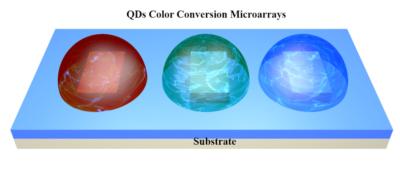Researchers from the Beijing Institute of Technology and MIIT have developed perovskite quantum dots microarrays with strong potential for quantum dots color conversion (QDCC) applications including micro-LEDs displays.

By using patterned black photoresist molds to make the QDs pixels, researchers have been able to increase the pixel thickness and avoid the optical crosstalk, a common but significant issue which prevents better printing results. But the manufacturing costs increased substantially. The research team set out to resolve these challenges by developing a method that creates PQDs with a robust 3D structure.
The fabricated PQDs microarrays reportedly exhibit characteristics that are desirable for QDCC applications, including 3D morphology with hemisphere shape and strong photoluminescence. These microarrays achieved strong and uniform photoluminescence in large area because of the seamless integration with in situ-fabricated PQDs. The researchers’ technique demonstrated the potential use of the in situ direct print photopolymerization method for fabricating patterned multicolor perovskite quantum dots microarrays with both wide color gamut and high resolution.

